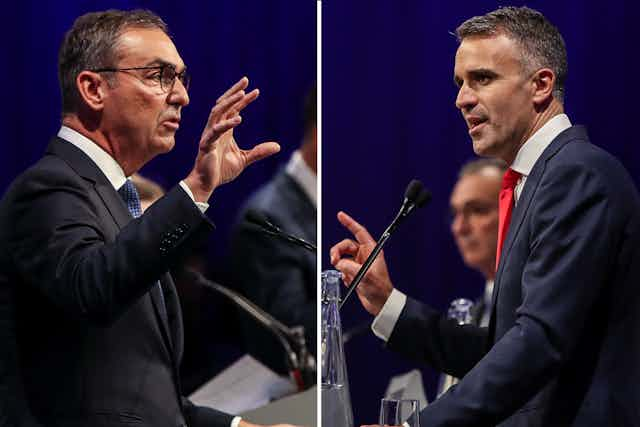The South Australian election is on Saturday, with polls closing at 6:30pm AEDT. A YouGov poll for The Advertiser, conducted March 7-13 from a sample of 835, gave Labor a 56-44 lead, compared with the 2018 election result of 51.9-48.1 to Liberal, so this poll would be about an 8% swing to Labor.
YouGov conducts Newspoll, so this poll can be compared with the Newspoll nearly three weeks ago. Labor gained three points after preferences, from primary votes of 41% Labor (up two), 33% Liberal (down four), 11% Greens (up one) and 15% for all Others (up one).
Read more: Labor maintains big federal Newspoll lead and is likely to win in South Australia
Liberal Premier Steven Marshall was at 48% dissatisfied, 46% satisfied, for a net approval of -2, down three points on Newspoll. Labor leader Peter Malinauskas had a net +19 approval, down one point. Malinauskas led as better premier by 45-40 (46-39 in Newspoll).
Labor held a 42-26 lead as best party to handle health and hospitals, which was rated the most important issue by 39% ahead of cost of living on 28%. Poll figures are from The Poll Bludger.
There are 47 single-member seats in the SA lower house. The Liberals won 25 seats to Labor’s 19 with three independents in 2018, but they are already in minority owing to defections to the crossbench. If this poll is near the election result, Labor will win a thumping majority in the lower house.
It’s very likely this will be the first time Labor wins the SA statewide two party vote since the 2006 state election. Labor retained power in both 2010 and 2014 despite losing the two party vote (by 53.0-47.0 in 2014).
Only votes cast on election day can be counted on the night in SA. These votes will likely be a low proportion of the overall turnout. It won’t be possible to call the result on election night unless it is very decisive.
What about the upper house?
This is a lower house poll, but upper house vote shares are usually similar to the lower house, with some drop for the major parties. 11 of the 22 upper house seats will be elected by statewide proportional representation. A quota is one-twelfth of the vote, or 8.3%.
Optional preferential voting above the line is used, so a single “1” above the line will only count for the party it is cast for. To give preferences for more parties, voters must continue numbering “2”, “3”, etc above the line. Owing to optional preferential, many votes will exhaust and about half a quota (4.2%) is likely to be enough to win.
Labor’s vote in this poll is nearly enough for five quotas – the Liberals would win four quotas and the Greens one without enough surplus to be in the hunt for a second seat. The last seat would probably go to one of the Others, with One Nation or SA-Best most likely.
Such a result would give Labor and the Greens six of the 11 seats up at this election, but the 2018 result was four Liberals, four Labor, two SA-Best and one Green. As these members continue until the 2026 election, the most likely outcome is a total of nine Labor, eight Liberals, two Greens, two SA-Best and one Other.
In this case, Labor and the Greens would together hold 11 of the 22 upper house seats after the election, and need one more vote to pass legislation opposed by the Liberals.
Federal polls from Morgan and WA
A federal Morgan poll, conducted March 3-13 from a sample of 1,947, gave Labor a 56-44 lead, a 0.5-point gain for the Coalition since early March. Primary votes were 37% Labor (down 0.5), 33.5% Coalition (down 0.5), 11.5% Greens (steady), 3% One Nation (down 0.5), 1% UAP (steady), 10.5% independents (up 1.5) and 3.5% others (steady).
The fieldwork dates for this Morgan poll overlap with those in the previous Morgan (February 24 to March 6).
The Poll Bludger reported Wednesday that Labor pollster Utting Research conducted polls in the Liberals’ four most marginal WA seats from March 11-14 from a combined sample of 750. Combining these results suggests a 10% swing to Labor from the 2019 election.
A Greens-commissioned WA federal poll gave Labor 42% of the primary vote, the Coalition 33% and the Greens 11%. Greens-commissioned polls usually overstate the Greens’ vote.

